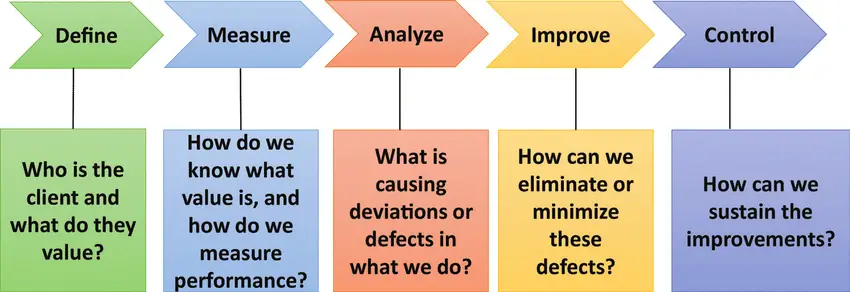The DMAIC Model
 The Six Sigma DMAIC model | Credit: Research GateOpens in new window
The Six Sigma DMAIC model | Credit: Research GateOpens in new window
DMAIC (an acronym for Define, Measure, Analyze, Improve, and Control ) is a Six SigmaOpens in new window roadmap. DMAIC is a data-driven improvement cycle used for improving, optimizing and stabilizing business processes and designs. |
The DMAIC model can be used to find and solve problems in existing processes. It can also be used to expand the current capabilities of an existing process by identifying opportunities to improve current processes.
The five phases of the DMAIC model are define, measure, analyze, improve, and control.
While this model suggests a linear progression with each phase leading to the next, there will always be some iterative work between the phases.
Each phase (as discussed briefly underneath) involves a certain amount of work to accomplish which is integral to the successful completion of a Six Sigma project (Ward & Poling 2004).
The Phases of DMAIC
- Define Phase
The define phase is for focusing the Six Sigma project and creating a roadmap with timeline to guide all project activities toward a successful conclusion.
Under the champion leadership, the project team works on mapping the process associated with all stakeholders of the process.
Logistical decisions about team members and meeting times are decided. The charter is finalized and signed off by everyone. If questions arise about availability of resources such as time or people, the champion helps resolves these issues.
- Measure Phase
The measure phase concentrates on collecting data to assess current process performance. It involves deciding all of the measures that are pertinent to the project.
These include the scorecard metrics that tie to the scoreboard of the organization as well as all critical-to-quality (CTQ) characteristics for the process.
All measure must be clearly identified and data collection plans for each one setup. Then data can be collected regularly for the analyze phase.
- Analyze Phase
In the analyze phase, the various techniques are used to determine how the current process performance compares to the performance goals in the project charter.
Here, data are analyzed with the express purpose of understanding why the current process works the way it does. Specifically, it is important to determine if the process has a predictable or unpredictable behavior.
- Predictable processes have routine sources of variation that are always present and impact the process day in and day out.
- Unpredictable processes have both routine sources of variation plus special, unpredictable sources of variation that can knock a process off track.
- Improve Phase
Activities in the improve phase are directed toward finding out how to improve the process.
This phase involves investigations to see what changes to the process will make the process better to meet the project goals.
The project team may conduct experiments to see what can be achieved and the associated costs. Once several solutions are identified, the project team can evaluate and pilot them for their potential benefits.
Before a final improvement solution is selected and implemented, the project team needs to assess any potential problems with all solutions. Resolution of all potential problems will assure that the solution will not be undermined in the future.
- Control Phase
The control phase in the DMAIC model must focus on making the changes permanent for sustained process improvement.
This means that the project team will work on those activities that are critical for the project team to turn over an improved process to the process owners.
To reap the benefits of any Six Sigma project, the improvements must be sustainable by the organization, not by the project team.
Elements included in the control phase are training of employees, control plans, and process measures that will keep attention on the process.
The transition from the control phase of the DMAIC model used by the project team back to the organization comes with the standardized and institutionalized phases.
See Also:
- Research data for this work have been adapted from the manuals:
- Schroeder, R. G., Linderman, K., Liedtke, C., & Choo, A. S. (2008). Six Sigma: Definition and underlying theory. Journal of Operations Management, 26, 536 – 554.
- Anderson, R., Eriksson, H., & Tortensson, H. (2006). Similarities and differences between TQM, Six Sigma and Lean. The TQM Magazine, 18 (3), 282 – 296.
- Salah, S., Carretero, J. A., & Rahim, A. (2009). Six Sigma and Total Quality Management (TQM): Similarities, differences and relationship. International Journal of Six Sigma and Competitive Advantage, 5 (3), 237 – 250.
- Klefsjo, B., Wiklund, H., & Edgeman, R. L. (2001). Six-Sigma seen as a methodology for total quality management. Measuring Business Excellence, 5 (1) 31 – 35.
- Terziovski, M. (2006). Quality management practices and their relationship with customer satisfaction and productivity improvement. Management Research News, 29 (7), 414 – 424.

